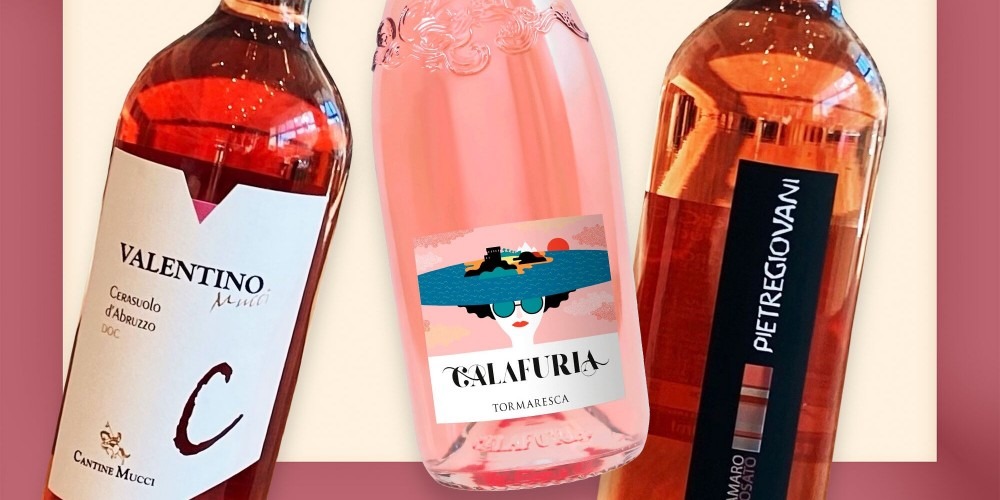Over the past few years, we've seen some misconceptions about rosé start to fade away. Wine enthusiasts have come to realize that rosé vinification can be a persnickety process that produces truly notable wines. Rosé lovers appreciate its 50-plus shades of pink and broad range of varietals, and how it can come from wine regions outside of Provence.
Wine regions in Italy, for example, have their own pink-hued drink called rosa. Until recently, Italians weren't as on board with the rosé wine trend because they don't drink rosé. But French rosés have gained so much popularity over the past ten years, and now the Italians want in. So they created an organization to re-introduce their finest Italian rosas known as the Rosautoctono Italian Wine Institute.
READ MORE: 19 Delicious Natural, Organic, and Biodynamic Rosés
Rosautoctono means "native pink," and the native grapes used to make rosa are Corvina Veronese, Groppello, Montepulciano, Bombino Nero, Negroamaro, and Gaglioppo. The movement was created to protect the ways Italian producers of pink wine cultivate their native grapes, challenge the dominance of French rosé, and spread awareness of Italian rosas. Bardolino Chiaretto, Valtènesi, Cerasuolo d'Abruzzo, Castel del Monte, Salice Salentino Rosato and Ciro Rosato are the six wine territories that make up Rosautoctono. The regions are known for their calcareous soils and old vines, and have a long history of producing top-quality rosas.
TJ Douglas, wine educator and founder of The Urban Grape, is a big fan of the movement. "The easiest way to think about Rosautoctono is as the anti 'Yes Way Rosé' movement," he says. "This isn't about drinking nameless, region-less rosé on Instagram for the likes. It's about digging deep into terroir and understanding why these areas of Italy are making world-class wine—that just happens to be pink. "
Rosas have a wide range of colors, from Strawberry gelato to San Marzano tomatoes, with notes that are savory, flavorful, and hearty. Here's a breakdown of Rosautoctono by its six regions, along with some bottles to try.
Bardolino
Chiaretto means "light" or "clear," and winemakers here have been producing rosas on the shores of Lago di Garda, in Veneto and Lombardy, by using the same grape-press technology since the ancient Roman era. Chiaretto from Lombardy has a light, salty character, and is low in alcohol and high in acidity. The native grapes used to make rosa on the eastern shore of Bardolino are juicy Corvina and herbaceous Rondinella, while producers on the western shores, in Lombardy, favor the native Groppello grape, known for its black-cherry notes.
We suggest: 2018 Zenato Bardolino Chiaretto ($14)
Valtenesi Chiaretto Wines
Chiaretto from Veneto includes viticulture from the smaller subzones in the northwest, like Garda Classico and Valtenesi. These rosas have a higher blend of the Gropello native grapes, making for a deep saturated color, floral aroma, and flavor profiles of nectarine, strawberry seed, and cherry skins.
We suggest: 2019 Costaripa Valtenesi Chiaretto Rosamara ($19)
Cerasuolo d’Abruzzo
Abruzzo's translucent Cerasuolo wines look like melted down Red Hots and smell like a bowl of cherries. These rosas are cultivated from the native Montepulciano grape which gives the wine a fuchsia hue and tart, balsamic-vinegar flavor qualities.
We suggest: Cantine Mucci "Valentino" Cerasuolo d'Abruzzo Rose ($18)
Castel del Monte Bombino Nero
Castel del Monte Puglian appellation wines are the star of the rosa scene thanks to the Negroamaro (black bitter) native grape that flourishes in Puglia's ample sunshine, cooling sea breezes, and calcareous soils. These red-tinted, juicy wines have characteristics of liquid roasted peppers and flavor profiles of sour Morello cherries with hints of tobacco, licorice, and coffee.
We suggest: 2019 Pietregiovani Negroamaro Rosato ($20)
Salice Salentino Rosato Wines
Salice Salentino is another small DOC Puglian appellation that shares the same native juicy and leathery Negroamaro grape as Castel del Morte. Salento bills itself as Italy's Rosato heartland as its copper-colored, chalky-clay vineyard soil is located on flat land, which helps the grapes retains moisture in the hottest part of the Italian boot.
We suggest: 2019 Calafuria Rosato Salento IGT ($15)
Ciro Rosato
Ciro Rosatos are grown in Calabria off the Ionian coast, which is the arch of the Italian boot. These orange-hued Rosatos are cultivated with the Gaglioppo native grape and are known for their red-berry aromas, high alcohol, and chunky tannins.
We suggest: Librandi Ciro Rosato ($12)





